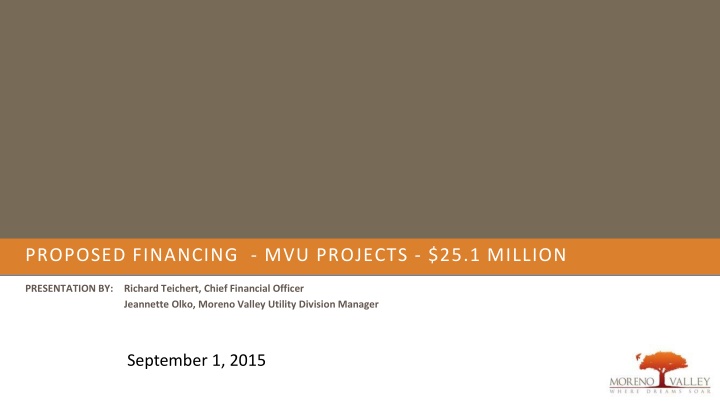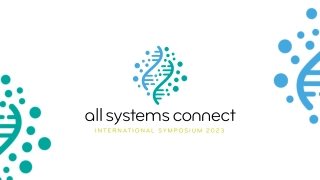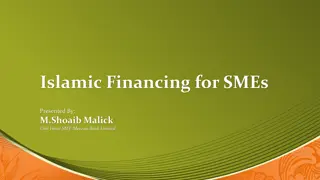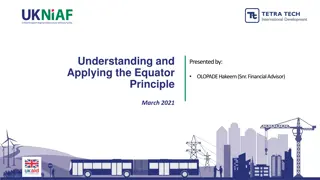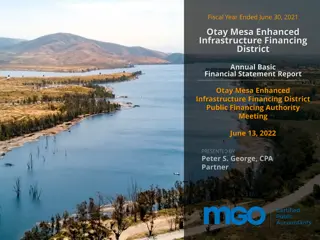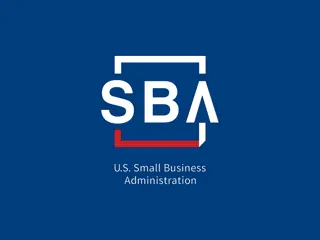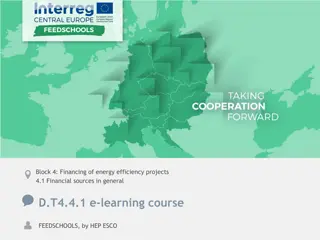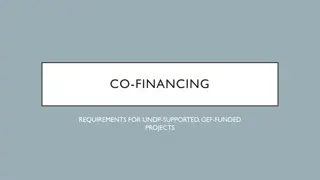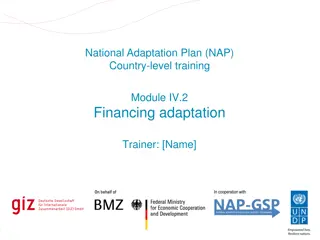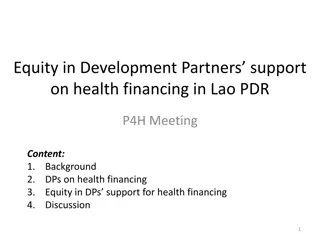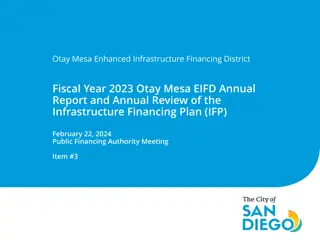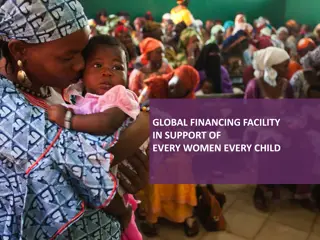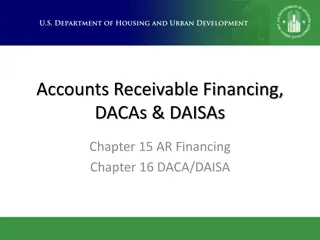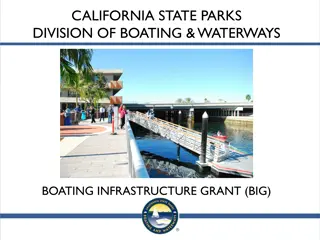Financing Vision for MVU Projects - $25.1 Million Presentation
Moreno Valley Utility Division established a municipally-owned utility to attract businesses, generate surplus revenue, and achieve financial stability. The Financial Vision for MVU aims to build reserves, issue tax-exempt debt, and ensure long-term financial health.
Download Presentation

Please find below an Image/Link to download the presentation.
The content on the website is provided AS IS for your information and personal use only. It may not be sold, licensed, or shared on other websites without obtaining consent from the author.If you encounter any issues during the download, it is possible that the publisher has removed the file from their server.
You are allowed to download the files provided on this website for personal or commercial use, subject to the condition that they are used lawfully. All files are the property of their respective owners.
The content on the website is provided AS IS for your information and personal use only. It may not be sold, licensed, or shared on other websites without obtaining consent from the author.
E N D
Presentation Transcript
PROPOSED FINANCING - MVU PROJECTS - $25.1 MILLION PRESENTATION BY: Richard Teichert, Chief Financial Officer Jeannette Olko, Moreno Valley Utility Division Manager September 1, 2015
Why did the City of Moreno Valley form a Municipally- Owned Utility? What are the benefits? The City was facing the threat of losing large tax based business to the City of Riverside lured by reduced electric rates offered by Riverside Public Utility (RPU) This was possible due to the City s 100 year old, financially stable Municipal Electric Utility The mature RPU generates surplus cash to the General Fund based on the City Charter and provides a source for economic development rate incentives to bring jobs and tax base to the City ($40 million annually) Moreno Valley City Council began the process of building a successful municipally- owned electric utility in 2004 to bring these same benefits to Moreno Valley The originating documents included statements that surplus revenue would be used to support additional police and fire services Economic development rates would attract critically needed businesses and jobs to the City The recession delayed the financial maturing of the Moreno Valley Utility (MVU) MVU is now generating significant surplus cash and is financially strong 2
What is the Financial Vision for MVU? MVU will generate a revenue surplus exceeding $3 million for FY 2014/15 Staff will work with City Council to establish direction to fund long needed reserves for the utility These include Equipment Replacement Reserves, Working Capital Reserves, Emergency Reserves and Rate Stabilization Reserves (estimated total need is a minimum of $14 million today) Establishing these reserves over the next 5 years will allow MVU to issue tax exempt debt as a municipally owned utility in 2021 With a strong balance sheet, the MVU debt will garner lower rates than general fund debt with tax exempt investors MVU may refinance the General Fund backed Taxable Lease Revenue Bonds as tax exempt debt of the utility - allowing the utility to stand alone as a financially stable entity Frees-up General Fund borrowing capacity for new projects 3
Why does the City want a financially strong Municipally Owned Utility? Financially strong MVU established with a properly funded balance sheet (est. FY 2021), the City can consider additional options to support City Services: The City may consider a charter - including a General Fund transfer from MVU to support services (police/fire) or reduce the Utility Users Tax (UUT) The City could consider breaking from SCE rate parity, providing an extra economic incentive to draw more businesses and jobs to the community Continue to be able to offer economic incentives for job creation and tax base development Tax base growth may allow weaning off of the UUT 4
How do we grow MVU and ensure the vitality of the Utility for years to come? Borrow money at low cost interest rates to build and expand MVU capacity timely to serve more customers, particularly large electric use customers: This approach allows the utility to have the capacity to grow and take advantage of the current rapid pace of development of large electricity consuming businesses Manage MVU like a business - A growing business either takes on equity investors or borrows money to invest in the business infrastructure As a public agency, the City (S&P rating of A+) and the Utility have access to the lowest borrowing rates available 5
MVU Projects proposed to be funded (included in CIP) Project Title Project Description Estimated Cost Install 115kV/12kV substation $13,489,000 Kitching Substation Install conduit and cable from Kitching to Edwin Rd. $480,000 Kitching Substation to Edwin Rd. Circuit going north towards Heacock for reliability $787,000 Kitching Backbone to Indian Allow part of Iris circuit to transfer to Kitching substation Kitching Substation to Perris Blvd. $414,000 Kitching Substation to Lasselle Sports Park Create a tie to Lasselle 12kV $477,000 Install cable from Iris to Indian $378,000 Load transfer to Iris Interconnect Connect new circuit to Globe interconnect $459,000 Kitching Substation to Globe 6
MVU Projects proposed to be funded (included in CIP) Project Title Project Description Estimated Cost Install conduit and cable along Modular Way to Perris Blvd. $465,000 Kitching Backbone to Perris Blvd. Ties Kitching substation to MoVal substation providing additional reliability $816,000 Kitching Nason 12kV tie Ties Centerpointe Interconnects to MoVal substation Ties Centerpointe Interconnects to South Industrial area Build automation, communication, and protection in circuits that serve critical customers $2,025,000 Alessandro Blvd. $1,396,350 Heacock St. $2,000,000 Electrical system automation Addition of a 3rdtransformer bank at MoVal substation. 50% of cost funded by bonds. MoVal Substation - 3rdtransformer bank $1,925,000 $25,111,350 Total 7
History of MVU Project Need and Financing Strategy The substation and reliability projects have been planned since early 2014 February 26, 2014: Need for the South Substation and Reliability projects identified in the Distribution System Plan (DSP) for years 2014 2018 June 2014: Identified property for Substation Project completed appraisal August 26, 2014: Closed session to discuss negotiation of property purchase October 21, 2014: Study Session regarding DSP and cost of service study November 18, 2014: City Council approved property purchase, use of General Fund line of credit to fund purchase and reimbursement agreement for GF to be reimbursed from future bond proceeds 8
History of MVU Financing Strategy and Need March 10, 2015: Request for Proposals completed Finance Subcommittee and City Council approve Financing Team to support future financings for the City Financing referenced is MVU projects totaling about $25 million April/May review and May 26, 2015 Approval: City Council approved the Fiscal Year 2015/16 Five Year Capital Improvement Program; CIP includes MVU projects, stating they are contingent upon a June 2015 bond issue to fund the projects June 26, 2015: MVU Utility Commission reviewed and discussed the proposed financing structure and projects. Approved by Commission on a 4-1 vote. June 25, 2015: Materials distributed for a June 29, 2015 Finance Subcommittee meeting meeting rescheduled to July 8, 2015 9
Time sensitivity of the project Recent large customers that have connected in the past 24 months: Proctor and Gamble Deckers Outdoor Amazon 1 Amazon 2 Fisker 10
Time sensitivity of the project Capacity Issues MVU South Substation with recent rapid building of distribution centers and manufacturing, known large customers put the current system infrastructure at capacity in 2016 To serve additional large usage customers (SEE MAP) substation completion is needed as early in 2017 as possible (project goal May 2017) System capacity expansion directly ties to continued Economic Development (ED) and Job Growth With Loss of Redevelopment Agency, MVU is most significant ED tool Reliability Improvements The balance of projects funded creates reliability by guaranteeing service through multiple source points Reliability is a key business attraction point for MVU The reliability projects will be completed by 2018 12
What occurs if capacity is not available for large projects? project time sensitive? If capacity is not available by May 2017: If substation project is not available when a developer is ready to connect, staff will need to advise the developer in 2016 to prepare to connect to SCE system to ensure service availability upon project completion Result loss of revenue stream for years . Negatively impacting the financial strength of MVU Staff is ready to proceed to prevent delays to the project 13
How do we grow MVU and ensure the vitality of the Utility for years to come? Borrow money at low cost interest rates to build and expand MVU capacity timely to serve more customers, particularly large electric use customers: This approach allows the utility to have the capacity to grow and take advantage of the current rapid development of large electricity consuming businesses Growing slower, MVU may lose some critical customers to SCE due to inadequate capacity to serve them when they need to connect MVU was caught slightly behind the curve in anticipating the pace of growth in the South Industrial Area This creates a current crisis to ensure the businesses entering the planning queue in the next few months will have the capacity in 2017 that they will need - TIME IS OF THE ESSENCE 14
Meeting the Goals of the MVU Vision Following this plan for growing the MVU business keeps the utility on course to achieve the following by about 2021: The City will have sufficient revenue to consider a charter that could include a General Fund transfer from MVU to support services priorities or reduce the Utility Users Tax The City could consider breaking from SCE rate parity, providing an extra economic incentive to draw more businesses and jobs to the community Continue to be able to offer economic incentives for job creation and tax base development Tax base growth provides support of Council priorities, which may include weaning off of the UUT 15
Proposed Alternative 1 Financing Structure Taxable Lease Revenue Bonds of the General Fund not to exceed $29 million Taxable due to the nature of the ENCO contract Lease Revenue Bonds allow the Council to determine the timing and business purpose of the issuance (does not require a vote of the electorate) Secured by property owned by the General Fund (Conference and Recreation Center, parks and fire stations) Callable in 6 years to prepare for the developing financial strength of MVU to be able to refinance debt in 2021; this will free up the GF assets for future GF financing projects 16
Other Financing Options Considered General Obligation Bonds Not a feasible option since it requires a vote earliest election date would be November 2016; need the project online by early 2017 Economists anticipate an increase in Fed Reserve rates by late 2015 No guarantee the vote would pass, essentially shutting down the economic development capacity of MVU Would require all citywide property owners to increase taxes to support the MVU rate payers Alternative 2 - Pay as You Go Current business strategy is to use the operating surplus to build a strong MVU balance sheet for the long term MVU to begin to issue its own debt by 2021 Pay as you GO would cannibalize the balance sheet to pay for infrastructure projects with operating revenue, while deferring building the MVU financial strength needed for the long term Funding to complete with Pay as you GO would push project completion out many years 17
Other Financing Options Considered Alternative 3 - Public Private Partnership (P3) MVU would need to start an RFP process that will take many months to complete delaying project completion Cost of capital is higher than the City s (A+ bond rating) Additional parties involved, adding a cost layer that is not necessary Any cost savings is typically from avoiding paying Prevailing Wages MVU will own the asset at completion, therefore prevailing wages is required The bulk of the $15 million substation is equipment; so avoiding prevailing wages will not have a great savings impact No opportunity to include an operating/maintenance element, since Enco has the private operating/maintenance contract through December 2020 18
Alternatives Alternative 1 - Proceed with the Proposed Taxable Lease Revenue Bond Financing Not to Exceed $29 million Allows the projects to move forward timely Currently a very favorable municipal bond market due to impacts of China and Greece economies struggling Alternative 2 - Proceed on a Pay as You Go basis Complete portions of the projects as funding allows Return to Council with a project timeline under this methodology Alternative 3 - Proceed to Prepare a Request for Proposals for a Public Private Partnership option Direct staff to return with a timeline for this approach (staff estimates an additional 6-9 months for this process) 19
Next Steps Moreno Valley Utilities Commission recommended Alternative 1 to Finance SubCommittee and City Council by a vote of 3-1 on August 21, 2015 Finance Subcommittee will give Council their recommendation from meeting on August 31, 2015 Staff recommends that the City Council direct staff to bring the documents required to proceed with Alternative 1, Lease Revenue Bond Financing in an amount not to exceed $29 million, to the September 8, 2015 City Council meeting for Council consideration Other options that City Council deem appropriate Direct staff to bring the City s Debt Management Policy for review and discussion at a future Study Session 20
